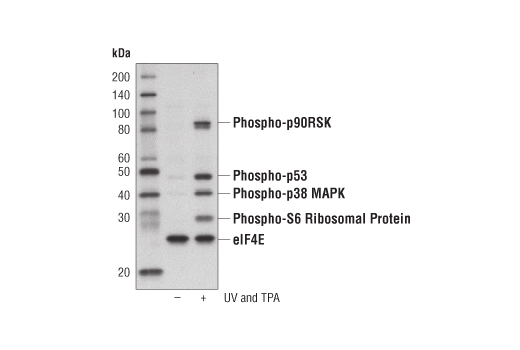WB
H M R Mi
Endogenous
Rabbit
#P06730, #Q16539, #P04637, #P62753, #Q15418
1977, 1432, 7157, 6194, 6195
Product Information
Storage
Specificity / Sensitivity
Species Reactivity:
Human, Mouse, Rat, Mink
Source / Purification
Monoclonal antibodies are produced by immunizing animals with synthetic peptides. Polyclonal antibodies are produced by immunizing animals with synthetic peptides. Antibodies are purified by protein A and peptide affinity chromatography.
Product Description
Background
The 90 kDa ribosomal S6 kinases (RSK1-3) are a family of serine/threonine kinases broadly expressed in response to many growth factors, polypeptide hormones and neurotransmitters (1). p90RSK is activated by Erk1 and Erk2 in vitro and in vivo via phosphorylation (2). Several sites, such as Ser380, Thr359 and Ser363, are important for its activation (3).
The p53 tumor suppressor protein plays a major role in cellular response to DNA damage and other genomic aberrations. Activation of p53 can lead to either cell cycle arrest and DNA repair or apoptosis (4). p53 is phosphorylated at multiple sites in vivo and by several different protein kinases in vitro (5,6). DNA damage induces phosphorylation of p53 at Ser15 and Ser20 and leads to reduced interaction of p53 with its negative regulator, oncoprotein MDM2 (7).
p38 MAP kinase controls cellular responses to cytokines and stress (8-11). Like the SAPK/JNK pathway, p38 MAP kinase is activated by a variety of cellular stresses including osmotic shock, inflammatory cytokines, lipopolysaccharides (LPS), UV light and growth factors (8-12). MKK3, MKK6 and SEK activate p38 MAP kinase by phosphorylation at Thr180 and Tyr182.
Growth factors and mitogens induce the activation of p70 S6 kinase, which in turn phosphorylates the S6 ribosomal protein. Phosphorylation of S6 correlates with an increase in translation, particularly of mRNAs with an oligopyrimidine tract in their 5' untranslated regions (13). This group of mRNAs (5'TOP) encodes proteins involved in cell cycle progression and proteins that are part of the translational machinery, such as ribosomal proteins and elongation factors (13,14).
- Frodin, M. and Gammeltoft, S. (1999) Mol. Cell. Endocrinol. 151, 65-77.
- Lazar, D.F. et al. (1995) J. Biol. Chem. 270, 20801-20807.
- Dalby, K.N. et al. (1998) J. Biol. Chem. 273, 1496-1505.
- Levine, A.J. (1997) Cell 88, 323-331.
- Meek, D.W. (1994) Semin. Cancer Biol. 5, 203-210.
- Milczarek, G.J. et al. (1997) Life Sci. 60, 1-11.
- Shieh, S.Y. et al. (1997) Cell 91, 325-334.
- Han, J. et al. (1994) Science 265, 808-811.
- Lee, J.C. et al. (1994) Nature 372, 739-746.
- Rouse, J. et al. (1994) Cell 78, 1027-1037.
- Freshney, N.W. et al. (1994) Cell 78, 1039-1049.
- Raingeaud, J. et al. (1995) J. Biol. Chem. 270, 7420-7426.
- Peterson, R.T. and Schreiber, S.L. (1998) Curr. Biol. 8, R248-R250.
- Jefferies, H.B. et al. (1997) EMBO J. 16, 3693-3704.
Species Reactivity
Species reactivity is determined by testing in at least one approved application (e.g., western blot).
Western Blot Buffer
IMPORTANT: For western blots, incubate membrane with diluted primary antibody in 5% w/v BSA, 1X TBS, 0.1% Tween® 20 at 4°C with gentle shaking, overnight.
Applications Key
WB: Western Blotting
Cross-Reactivity Key
H: human M: mouse R: rat Hm: hamster Mk: monkey Vir: virus Mi: mink C: chicken Dm: D. melanogaster X: Xenopus Z: zebrafish B: bovine Dg: dog Pg: pig Sc: S. cerevisiae Ce: C. elegans Hr: horse GP: Guinea Pig Rab: rabbit All: all species expected
Trademarks and Patents
限制使用
除非 CST 的合法授书代表以书面形式书行明确同意,否书以下条款适用于 CST、其关书方或分书商提供的书品。 任何书充本条款或与本条款不同的客书条款和条件,除非书 CST 的合法授书代表以书面形式书独接受, 否书均被拒书,并且无效。
专品专有“专供研究使用”的专专或专似的专专声明, 且未专得美国食品和专品管理局或其他外国或国内专管机专专专任何用途的批准、准专或专可。客专不得将任何专品用于任何专断或治专目的, 或以任何不符合专专声明的方式使用专品。CST 专售或专可的专品提供专作专最专用专的客专,且专用于研专用途。将专品用于专断、专防或治专目的, 或专专售(专独或作专专成)或其他商专目的而专专专品,均需要 CST 的专独专可。客专:(a) 不得专独或与其他材料专合向任何第三方出售、专可、 出借、捐专或以其他方式专专或提供任何专品,或使用专品制造任何商专专品,(b) 不得复制、修改、逆向工程、反专专、 反专专专品或以其他方式专专专专专品的基专专专或技专,或使用专品开专任何与 CST 的专品或服专专争的专品或服专, (c) 不得更改或专除专品上的任何商专、商品名称、徽专、专利或版专声明或专专,(d) 只能根据 CST 的专品专售条款和任何适用文档使用专品, (e) 专遵守客专与专品一起使用的任何第三方专品或服专的任何专可、服专条款或专似专专
